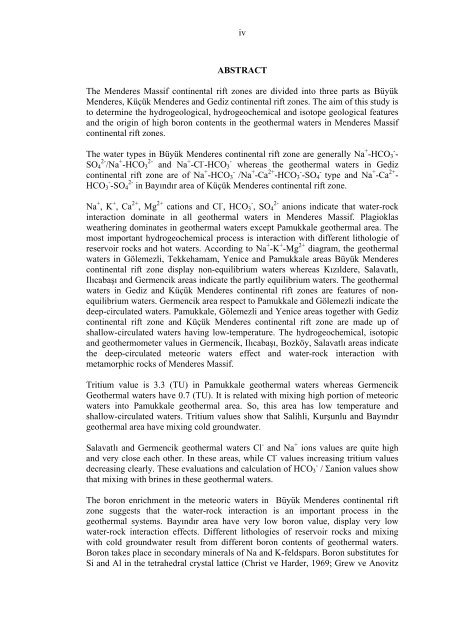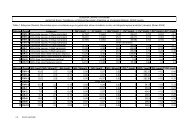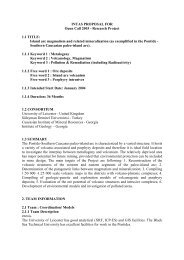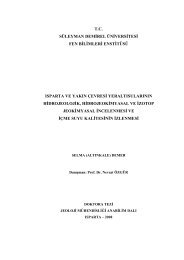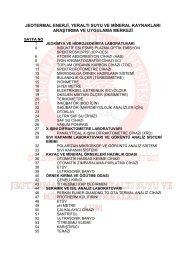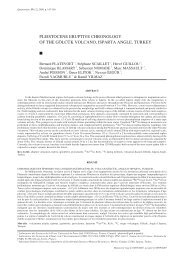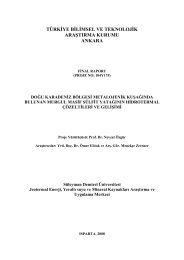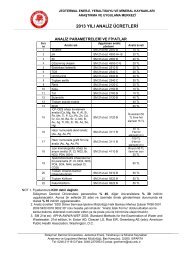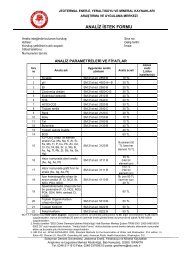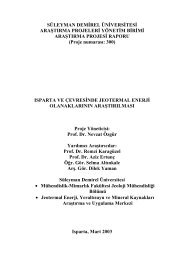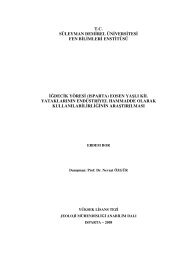tc süleyman demirel üniversitesi fen bilimleri enstitüsü menderes
tc süleyman demirel üniversitesi fen bilimleri enstitüsü menderes
tc süleyman demirel üniversitesi fen bilimleri enstitüsü menderes
You also want an ePaper? Increase the reach of your titles
YUMPU automatically turns print PDFs into web optimized ePapers that Google loves.
iv<br />
ABSTRACT<br />
The Menderes Massif continental rift zones are divided into three parts as Büyük<br />
Menderes, Küçük Menderes and Gediz continental rift zones. The aim of this study is<br />
to determine the hydrogeological, hydrogeochemical and isotope geological features<br />
and the origin of high boron contents in the geothermal waters in Menderes Massif<br />
continental rift zones.<br />
The water types in Büyük Menderes continental rift zone are generally Na + -HCO3 - -<br />
SO4 2- /Na + -HCO3 2- and Na + -Cl - -HCO3 - whereas the geothermal waters in Gediz<br />
continental rift zone are of Na + -HCO3 - /Na + -Ca 2+ -HCO3 - -SO4 - type and Na + -Ca 2+ -<br />
HCO3 - -SO4 2- in Bayındır area of Küçük Menderes continental rift zone.<br />
Na + , K + , Ca 2+ , Mg 2+ cations and Cl - , HCO3 - , SO4 2- anions indicate that water-rock<br />
interaction dominate in all geothermal waters in Menderes Massif. Plagioklas<br />
weathering dominates in geothermal waters except Pamukkale geothermal area. The<br />
most important hydrogeochemical process is interaction with different lithologie of<br />
reservoir rocks and hot waters. According to Na + -K + -Mg 2+ diagram, the geothermal<br />
waters in Gölemezli, Tekkehamam, Yenice and Pamukkale areas Büyük Menderes<br />
continental rift zone display non-equilibrium waters whereas Kızıldere, Salavatlı,<br />
Ilıcabaşı and Germencik areas indicate the partly equilibrium waters. The geothermal<br />
waters in Gediz and Küçük Menderes continental rift zones are features of nonequilibrium<br />
waters. Germencik area respect to Pamukkale and Gölemezli indicate the<br />
deep-circulated waters. Pamukkale, Gölemezli and Yenice areas together with Gediz<br />
continental rift zone and Küçük Menderes continental rift zone are made up of<br />
shallow-circulated waters having low-temperature. The hydrogeochemical, isotopic<br />
and geothermometer values in Germencik, Ilıcabaşı, Bozköy, Salavatlı areas indicate<br />
the deep-circulated meteoric waters effect and water-rock interaction with<br />
metamorphic rocks of Menderes Massif.<br />
Tritium value is 3.3 (TU) in Pamukkale geothermal waters whereas Germencik<br />
Geothermal waters have 0.7 (TU). It is related with mixing high portion of meteoric<br />
waters into Pamukkale geothermal area. So, this area has low temperature and<br />
shallow-circulated waters. Tritium values show that Salihli, Kurşunlu and Bayındır<br />
geothermal area have mixing cold groundwater.<br />
Salavatlı and Germencik geothermal waters Cl - and Na + ions values are quite high<br />
and very close each other. In these areas, while Cl - values increasing tritium values<br />
decreasing clearly. These evaluations and calculation of HCO3 - / Σanion values show<br />
that mixing with brines in these geothermal waters.<br />
The boron enrichment in the meteoric waters in Büyük Menderes continental rift<br />
zone suggests that the water-rock interaction is an important process in the<br />
geothermal systems. Bayındır area have very low boron value, display very low<br />
water-rock interaction effects. Different lithologies of reservoir rocks and mixing<br />
with cold groundwater result from different boron contents of geothermal waters.<br />
Boron takes place in secondary minerals of Na and K-feldspars. Boron substitutes for<br />
Si and Al in the tetrahedral crystal lattice (Christ ve Harder, 1969; Grew ve Anovitz


